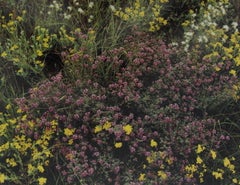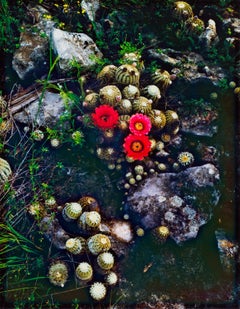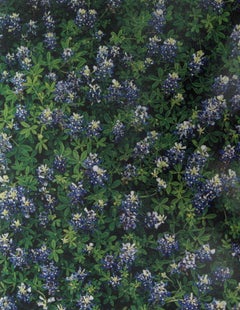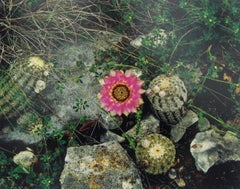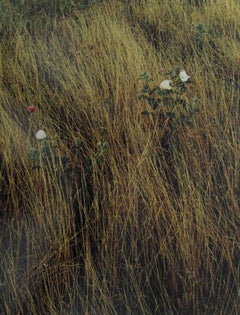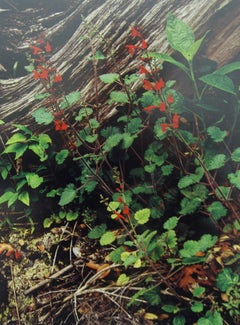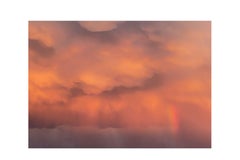Jim Bones Art
to
5
6
1
4
2
6
Overall Height
to
Overall Width
to
6
3
3
2
1
1
1
1
1
1
1
1
1
1
6
6
6,827
3,109
2,517
1,217
6
Artist: Jim Bones
Purple Loco, Yellow Paper Daisy, White Dematis, Davis, Mountains, Texas
By Jim Bones
Located in Dallas, TX
Edition of 30
Signed, titled, dated and numbered
Artist Copyright Stamp
Texas Wildflowers Portfolio 1979
Category
20th Century Post-Modern Jim Bones Art
Materials
Dye Transfer
Lace Cactus
By Jim Bones
Located in Austin, TX
"Lace Cacuts"
Artist: Jim Brown
Medium: Dye Transfer Print
Size: 15" x 11.5"
Framed
Category
20th Century Jim Bones Art
Materials
Dye Transfer
Bluebonnets, Spicewood Springs, Texas
By Jim Bones
Located in Dallas, TX
Edition of 30
Signed, titled, dated, and numbered
Artist Copyright Stamp
Texas Wildflower Portfolio 1979
Category
20th Century Post-Modern Jim Bones Art
Materials
Dye Transfer
Lace Cactus and Yellow Sand, Austin, Texas
By Jim Bones
Located in Dallas, TX
Edition of 30
Signed, titled, dated and numbered
Artist Copyright Stamp
Texas Wildflower Portfolio 1979
Category
20th Century Post-Modern Jim Bones Art
Materials
Dye Transfer
Prickly Poppy, Thistle and Field Grass, Central Texas
By Jim Bones
Located in Dallas, TX
Edition of 30
Signed, titled, dated and numbered
Artist Copyright Stamp
Texas Wildflowers Portfolio 1979
Category
20th Century Post-Modern Jim Bones Art
Materials
Dye Transfer
Cedar Sage, Barton Creek, Texas
By Jim Bones
Located in Dallas, TX
Edition of 30
Signed, titled, dated and numbered
Artist Copyright Stamp
Texas Wildflower Portfolio 1979
Category
20th Century Post-Modern Jim Bones Art
Materials
Dye Transfer
Related Items
Painted Rainbows
By Julian Lennon
Located in Santa Monica, CA
Julian Lennon’s photographs serve as allegorical vehicles in this time of heightened awareness for our planet’s peril. In surveilling these ever-changing skies, Atmospheria celebrate...
Category
2010s Contemporary Jim Bones Art
Materials
Dye Transfer
Pop Art Vintage Photograph Dye Transfer Print "Leonardo's Lady" Audrey Flack
By Audrey Flack
Located in Surfside, FL
Hand signed and titled in ink by the artist from edition of 50 (plus proofs). Color Photo printed at CVI Lab by master printer Guy Stricherz. Published by Prestige Art Ltd. From the color saturated 1980's. A portrait by Leonardo da Vinci, nail polish, a pink rose, pocket watch, green pear. "Leonardo's Lady" a still life tableaux.
Audrey L. Flack (born May 30, 1931 in New York City, New York) is an American artist. Her work pioneered the art genre of photorealism; her work encompasses painting, sculpture, and photography. From Audrey Flack: 12 Photographs 1973 to 1983. A set of this portfolio is in the collections of the Harvard Art Museums. The Kodakchrome photos were photgraphed with a NIkon camera, the Ektachrome photographs were taken with a Hasselblad camera. Each negative was printed on a 20 X24 inche fiber based paper, dry mounted wth seal MT5 dry mounting tissue to 4 ply 100% cotton fiber board by Arnon Ben-David and Ari Rivera Gonzales under the supervision of Carol Brower.
Flack has numerous academic degrees, including both a graduate and an honorary doctorate degree from Cooper Union in New York City. Additionally she has a bachelor's degree in Fine Arts from Yale University and attended New York University Institute of Fine Arts where she studied art history. In May 2015, Flack received an honorary Doctor of Fine Arts degree from Clark University, where she also gave a commencement address.
Flack's work is displayed in several major museums, including the Museum of Modern Art, the Metropolitan Museum of Art, the Whitney Museum of American Art, and the Solomon R. Guggenheim Museum. Flack's photorealist paintings were the first such paintings to be purchased for the Museum of Modern Art’s permanent collection, and her legacy as a photorealist lives on to influence many American and International artists today. J. B. Speed Art Museum in Louisville, Kentucky, organized a retrospective of her work, and Flack’s pioneering efforts into the world of photorealism popularized the genre to the extent that it remains today.
Flack attended New York's High School of Music & Art. She studied fine arts in New York from 1948 to 1953, studying under Josef Albers among others. She earned a graduate degree and received an honorary doctorate from Cooper Union in New York City, and a Bachelor of Fine Arts from Yale University. She studied art history at the Institute of Fine Arts, New York University.
1953 New York University Institute of Fine Arts, New York City
1952 BFA, Yale University, New Haven, Connecticut
1948-51 Cooper Union, New York City
Career
Flack's early work in the 1950s was abstract expressionist; one such painting paid tribute to Franz Kline. Most influential amongst her early supporters was the Bauhaus artist Josef Albers. It was he who persuaded Flack to take up a scholarship at Yale with the mission of shaking up the institution's stuffy academic reputation. The ironic kitsch themes in her early work influenced Jeff Koons. But gradually, Flack became a New Realist and then evolved into photorealism during the 1960s. Her move to the photorealist style was in part because she wanted her art to communicate to the viewer. She was the first photorealist painter to be added to the collection of the Museum of Modern Art in 1966. Between 1976 and 1978 she painted her Vanitas series, including the piece Marilyn.
The critic Graham Thompson wrote, "One demonstration of the way photography became assimilated into the art world is the success of photorealist painting in the late 1960s and early 1970s. It is also called super-realism, radical realism, or hyper-realism and painters like Richard Estes, Chuck Close, and Audrey Flack as well, often worked from photographic stills to create paintings that appeared to be photographs."
In the early 1980s Flack's artistic medium shifted from painting to sculpture. She describes this shift as a desire for "something solid, real, tangible. Something to hold and to hold on to." Flack discusses the fact that she is self-taught in sculpture. She incorporates religion and mythology into her sculpture rather than the historical or everyday subjects of her paintings. Her sculptures often demonstrate a connection to the female form, including a series of diverse, heroic women and goddess figures. These depictions of women differ from those of traditional femininity, but rather are athletic, older, and strong. As Flack describes them: "they are real yet idealized... the 'goddesses in everywoman.'"
Flack has claimed to have found the photorealist movement too restricting, and now gains much of her inspiration from Baroque art.
Flack is currently represented by the Louis K. Meisel Gallery and Hollis Taggart Galleries. Her work is held in the collections of museums around the world, including the Metropolitan Museum of Art, The Museum of Modern Art, the Solomon R. Guggenheim Museum, the Whitney Museum of American Art, the Allen Memorial Art Museum, and the National Gallery of Australia in Canberra, Australia.
She was awarded the St. Gaudens Medal from Cooper Union, and the honorary Albert Dome professorship from Bridgeport University. She is an honorary professor at George Washington University, is currently a visiting professor at the University of Pennsylvania and has taught and lectured extensively both nationally, and internationally.
Flack lives and works in New York City and Long Island.
Audrey Flack is best known for her photo-realist paintings and was one of the first artists to use photographs as the basis for painting. The genre, taking its cues from Pop Art, incorporates depictions of the real and the regular, from advertisements to cars to cosmetics. Flack's work brings in everyday household items like tubes of lipstick, perfume bottles, Hispanic Madonnas, and fruit. These inanimate objects often disturb or crowd the pictorial space, which are often composed as table-top still lives. Flack often brings in actual accounts of history into her photorealist paintings, such as World War II' (Vanitas) and Kennedy Motorcade. Women were frequently the subject of her photo realist paintings. In her Neoclassical public sculpture of gilded bronze...
Category
1980s Photorealist Jim Bones Art
Materials
Photographic Paper, C Print, Dye Transfer
Pop Art Vintage Color Photograph Dye Transfer Print "Queen" Audrey Flack Photo
By Audrey Flack
Located in Surfside, FL
Hand signed and titled in ink by the artist from edition of 50 (plus proofs). Color Photo printed at CVI Lab by master printer Guy Stricherz. Published by Prestige Art Ltd. From the color saturated 1980's. "Queen" featuring a red rose, paint, a cameo portrait locket, makeup, a chess piece, a pocket watch and a red lucite dice piece
.
Audrey L. Flack (born May 30, 1931 in New York City, New York) is an American artist. Her work pioneered the art genre of photorealism; her work encompasses painting, sculpture, and photography. From Audrey Flack: 12 Photographs 1973 to 1983. A set of this portfolio is in the collections of the Harvard Art Museums. The Kodakchrome photos were photgraphed with a NIkon camera, the Ektachrome photographs were taken with a Hasselblad camera. Each negative was printed on a 20 X24 inche fiber based paper, dry mounted wth seal MT5 dry mounting tissue to 4 ply 100% cotton fiber board by Arnon Ben-David and Ari Rivera Gonzales under the supervision of Carol Brower.
Flack has numerous academic degrees, including both a graduate and an honorary doctorate degree from Cooper Union in New York City. Additionally she has a bachelor's degree in Fine Arts from Yale University and attended New York University Institute of Fine Arts where she studied art history. In May 2015, Flack received an honorary Doctor of Fine Arts degree from Clark University, where she also gave a commencement address.
Flack's work is displayed in several major museums, including the Museum of Modern Art, the Metropolitan Museum of Art, the Whitney Museum of American Art, and the Solomon R. Guggenheim Museum. Flack's photorealist paintings were the first such paintings to be purchased for the Museum of Modern Art’s permanent collection, and her legacy as a photorealist lives on to influence many American and International artists today. J. B. Speed Art Museum in Louisville, Kentucky, organized a retrospective of her work, and Flack’s pioneering efforts into the world of photorealism popularized the genre to the extent that it remains today.
Flack attended New York's High School of Music & Art. She studied fine arts in New York from 1948 to 1953, studying under Josef Albers among others. She earned a graduate degree and received an honorary doctorate from Cooper Union in New York City, and a Bachelor of Fine Arts from Yale University. She studied art history at the Institute of Fine Arts, New York University.
1953 New York University Institute of Fine Arts, New York City
1952 BFA, Yale University, New Haven, Connecticut
1948-51 Cooper Union, New York City
Career
Flack's early work in the 1950s was abstract expressionist; one such painting paid tribute to Franz Kline. Most influential amongst her early supporters was the Bauhaus artist Josef Albers. It was he who persuaded Flack to take up a scholarship at Yale with the mission of shaking up the institution's stuffy academic reputation. The ironic kitsch themes in her early work influenced Jeff Koons. But gradually, Flack became a New Realist and then evolved into photorealism during the 1960s. Her move to the photorealist style was in part because she wanted her art to communicate to the viewer. She was the first photorealist painter to be added to the collection of the Museum of Modern Art in 1966. Between 1976 and 1978 she painted her Vanitas series, including the piece Marilyn.
The critic Graham Thompson wrote, "One demonstration of the way photography became assimilated into the art world is the success of photorealist painting in the late 1960s and early 1970s. It is also called super-realism, radical realism, or hyper-realism and painters like Richard Estes, Chuck Close, and Audrey Flack as well, often worked from photographic stills to create paintings that appeared to be photographs."
In the early 1980s Flack's artistic medium shifted from painting to sculpture. She describes this shift as a desire for "something solid, real, tangible. Something to hold and to hold on to." Flack discusses the fact that she is self-taught in sculpture. She incorporates religion and mythology into her sculpture rather than the historical or everyday subjects of her paintings. Her sculptures often demonstrate a connection to the female form, including a series of diverse, heroic women and goddess figures. These depictions of women differ from those of traditional femininity, but rather are athletic, older, and strong. As Flack describes them: "they are real yet idealized... the 'goddesses in everywoman.'"
Flack has claimed to have found the photorealist movement too restricting, and now gains much of her inspiration from Baroque art.
Flack is currently represented by the Louis K. Meisel Gallery and Hollis Taggart Galleries. Her work is held in the collections of museums around the world, including the Metropolitan Museum of Art, The Museum of Modern Art, the Solomon R. Guggenheim Museum, the Whitney Museum of American Art, the Allen Memorial Art Museum, and the National Gallery of Australia in Canberra, Australia.
She was awarded the St. Gaudens Medal from Cooper Union, and the honorary Albert Dome professorship from Bridgeport University. She is an honorary professor at George Washington University, is currently a visiting professor at the University of Pennsylvania and has taught and lectured extensively both nationally, and internationally.
Flack lives and works in New York City and Long Island.
Audrey Flack is best known for her photo-realist paintings and was one of the first artists to use photographs as the basis for painting. The genre, taking its cues from Pop Art, incorporates depictions of the real and the regular, from advertisements to cars to cosmetics. Flack's work brings in everyday household items like tubes of lipstick, perfume bottles, Hispanic Madonnas, and fruit. These inanimate objects often disturb or crowd the pictorial space, which are often composed as table-top still lives. Flack often brings in actual accounts of history into her photorealist paintings, such as World War II' (Vanitas) and Kennedy Motorcade. Women were frequently the subject of her photo realist paintings. In her Neoclassical public sculpture of gilded bronze...
Category
1980s Photorealist Jim Bones Art
Materials
Photographic Paper, C Print, Dye Transfer
Pop Art Color Photograph Dye Transfer Print Audrey Flack Rolls Royce Lady Photo
By Audrey Flack
Located in Surfside, FL
Hand signed and titled in ink by the artist from edition of 50 (plus proofs). Color Photo printed at CVI Lab by master printer Guy Stricherz. Published by Prestige Art Ltd. From the color saturated 1980's. "Rolls Royce Lady" featuring a sculpture the Spirit of Ecstasy, a crystal goblet, dice, flowers, a pocket watch, jewelry, perfume and a red rose.
Audrey L. Flack (born May 30, 1931 in New York City, New York) is an American artist. Her work pioneered the art genre of photorealism; her work encompasses painting, sculpture, and photography. From Audrey Flack: 12 Photographs 1973 to 1983. A set of this portfolio is in the collections of the Harvard Art Museums. The Kodakchrome photos were photgraphed with a NIkon camera, the Ektachrome photographs were taken with a Hasselblad camera. Each negative was printed on a 20 X24 inche fiber based paper, dry mounted wth seal MT5 dry mounting tissue to 4 ply 100% cotton fiber board by Arnon Ben-David and Ari Rivera Gonzales under the supervision of Carol Brower.
Flack has numerous academic degrees, including both a graduate and an honorary doctorate degree from Cooper Union in New York City. Additionally she has a bachelor's degree in Fine Arts from Yale University and attended New York University Institute of Fine Arts where she studied art history. In May 2015, Flack received an honorary Doctor of Fine Arts degree from Clark University, where she also gave a commencement address.
Flack's work is displayed in several major museums, including the Museum of Modern Art, the Metropolitan Museum of Art, the Whitney Museum of American Art, and the Solomon R. Guggenheim Museum. Flack's photorealist paintings were the first such paintings to be purchased for the Museum of Modern Art’s permanent collection, and her legacy as a photorealist lives on to influence many American and International artists today. J. B. Speed Art Museum in Louisville, Kentucky, organized a retrospective of her work, and Flack’s pioneering efforts into the world of photorealism popularized the genre to the extent that it remains today.
Flack attended New York's High School of Music & Art. She studied fine arts in New York from 1948 to 1953, studying under Josef Albers among others. She earned a graduate degree and received an honorary doctorate from Cooper Union in New York City, and a Bachelor of Fine Arts from Yale University. She studied art history at the Institute of Fine Arts, New York University.
1953 New York University Institute of Fine Arts, New York City
1952 BFA, Yale University, New Haven, Connecticut
1948-51 Cooper Union, New York City
Career
Flack's early work in the 1950s was abstract expressionist; one such painting paid tribute to Franz Kline. Most influential amongst her early supporters was the Bauhaus artist Josef Albers. It was he who persuaded Flack to take up a scholarship at Yale with the mission of shaking up the institution's stuffy academic reputation. The ironic kitsch themes in her early work influenced Jeff Koons. But gradually, Flack became a New Realist and then evolved into photorealism during the 1960s. Her move to the photorealist style was in part because she wanted her art to communicate to the viewer. She was the first photorealist painter to be added to the collection of the Museum of Modern Art in 1966. Between 1976 and 1978 she painted her Vanitas series, including the piece Marilyn.
The critic Graham Thompson wrote, "One demonstration of the way photography became assimilated into the art world is the success of photorealist painting in the late 1960s and early 1970s. It is also called super-realism, radical realism, or hyper-realism and painters like Richard Estes, Chuck Close, and Audrey Flack as well, often worked from photographic stills to create paintings that appeared to be photographs."
In the early 1980s Flack's artistic medium shifted from painting to sculpture. She describes this shift as a desire for "something solid, real, tangible. Something to hold and to hold on to." Flack discusses the fact that she is self-taught in sculpture. She incorporates religion and mythology into her sculpture rather than the historical or everyday subjects of her paintings. Her sculptures often demonstrate a connection to the female form, including a series of diverse, heroic women and goddess figures. These depictions of women differ from those of traditional femininity, but rather are athletic, older, and strong. As Flack describes them: "they are real yet idealized... the 'goddesses in everywoman.'"
Flack has claimed to have found the photorealist movement too restricting, and now gains much of her inspiration from Baroque art.
Flack is currently represented by the Louis K. Meisel Gallery and Hollis Taggart Galleries. Her work is held in the collections of museums around the world, including the Metropolitan Museum of Art, The Museum of Modern Art, the Solomon R. Guggenheim Museum, the Whitney Museum of American Art, the Allen Memorial Art Museum, and the National Gallery of Australia in Canberra, Australia.
She was awarded the St. Gaudens Medal from Cooper Union, and the honorary Albert Dome professorship from Bridgeport University. She is an honorary professor at George Washington University, is currently a visiting professor at the University of Pennsylvania and has taught and lectured extensively both nationally, and internationally.
Flack lives and works in New York City and Long Island.
Audrey Flack is best known for her photo-realist paintings and was one of the first artists to use photographs as the basis for painting. The genre, taking its cues from Pop Art, incorporates depictions of the real and the regular, from advertisements to cars to cosmetics. Flack's work brings in everyday household items like tubes of lipstick, perfume bottles, Hispanic Madonnas, and fruit. These inanimate objects often disturb or crowd the pictorial space, which are often composed as table-top still lives. Flack often brings in actual accounts of history into her photorealist paintings, such as World War II' (Vanitas) and Kennedy Motorcade. Women were frequently the subject of her photo realist paintings. In her Neoclassical public sculpture of gilded bronze angels...
Category
1980s Photorealist Jim Bones Art
Materials
Photographic Paper, C Print, Dye Transfer
Pop Art Color Photograph Dye Transfer Print Audrey Flack "Skull & Roses" Photo
By Audrey Flack
Located in Surfside, FL
Hand signed and titled in ink by the artist from edition of 50 (plus proofs). Color Photo printed at CVI Lab by master printer Guy Stricherz. Published by Prestige Art Ltd. From the ...
Category
1980s Photorealist Jim Bones Art
Materials
Dye Transfer, Photographic Paper, C Print
David Byrne, Los Angeles, 1986 Signed, Framed, ChromaLuxe aluminium Print
By Annie Leibovitz
Located in Los Angeles, CA
Art Edition “David Byrne” (No. 1–275). Hardcover volume in a slipcase, accompanied by the portrait David Byrne, Los Angeles, 1986.
For over 50 years, Annie Leibovitz has been creating a body of work that is unequaled in breadth and influence. From the viscerally immediate reportage made for Rolling Stone magazine in the 1970s and extending through the more stylized portraiture of her work for Vanity Fair and Vogue, her pictures make up what is essentially a family album of our time.
In 2014, in close collaboration with Annie, TASCHEN published a SUMO edition of her work: over 200 photographs, many of them famous (the naked John Lennon entwined in a last embrace with Yoko Ono, Patti Smith on fire) and some rarely, if ever, seen before. In 2022, to accommodate a wider audience, this volume was recreated as an unlimited XXL edition.
The XXL volume is now available as an Art Edition in four different versions, each accompanied by a signed, numbered and framed dye-sublimation ChromaLuxe aluminum print. David Byrne, Los Angeles, 1986 is included in an edition of 275 copies.
In 1986, David Byrne wrote, directed and starred in his only feature film, True Stories. It was a quirky view of life in small-town rural Texas. Several of his collaborators on the project were from the downtown New York performing-arts world. Music was an integral element in the film and much of it was supplied by Byrne’s band, the Talking Heads...
Category
21st Century and Contemporary Jim Bones Art
Materials
Dye Transfer
Free Shipping
H 23.9 in W 19.7 in
Pop Art Vintage Color Photograph Dye Transfer Print "Royal Flush" Audrey Flack
By Audrey Flack
Located in Surfside, FL
Hand signed and titled in ink by the artist from edition of 50 (plus proofs). Color Photo printed at CVI Lab by master printer Guy Stricherz. Published by Prestige Art Ltd. From the color saturated 1980's. Royal Flush, cigars, Jack Daniels Whiskey, cash, playing cards and beer. Boys night out. perfect for the man cave or bachelor pad.
Audrey L. Flack (born May 30, 1931 in New York City, New York) is an American artist. Her work pioneered the art genre of photorealism; her work encompasses painting, sculpture, and photography. From Audrey Flack: 12 Photographs 1973 to 1983. A set of this portfolio is in the collections of the Harvard Art Museums. The Kodakchrome photos were photgraphed with a NIkon camera, the Ektachrome photographs were taken with a Hasselblad camera. Each negative was printed on a 20 X24 inche fiber based paper, dry mounted wth seal MT5 dry mounting tissue to 4 ply 100% cotton fiber board by Arnon Ben-David and Ari Rivera Gonzales under the supervision of Carol Brower.
Flack has numerous academic degrees, including both a graduate and an honorary doctorate degree from Cooper Union in New York City. Additionally she has a bachelor's degree in Fine Arts from Yale University and attended New York University Institute of Fine Arts where she studied art history. In May 2015, Flack received an honorary Doctor of Fine Arts degree from Clark University, where she also gave a commencement address.
Flack's work is displayed in several major museums, including the Museum of Modern Art, the Metropolitan Museum of Art, the Whitney Museum of American Art, and the Solomon R. Guggenheim Museum. Flack's photorealist paintings were the first such paintings to be purchased for the Museum of Modern Art’s permanent collection, and her legacy as a photorealist lives on to influence many American and International artists today. J. B. Speed Art Museum in Louisville, Kentucky, organized a retrospective of her work, and Flack’s pioneering efforts into the world of photorealism popularized the genre to the extent that it remains today.
Flack attended New York's High School of Music & Art. She studied fine arts in New York from 1948 to 1953, studying under Josef Albers among others. She earned a graduate degree and received an honorary doctorate from Cooper Union in New York City, and a Bachelor of Fine Arts from Yale University. She studied art history at the Institute of Fine Arts, New York University.
1953 New York University Institute of Fine Arts, New York City
1952 BFA, Yale University, New Haven, Connecticut
1948-51 Cooper Union, New York City
Career
Flack's early work in the 1950s was abstract expressionist; one such painting paid tribute to Franz Kline. Most influential amongst her early supporters was the Bauhaus artist Josef Albers. It was he who persuaded Flack to take up a scholarship at Yale with the mission of shaking up the institution's stuffy academic reputation. The ironic kitsch themes in her early work influenced Jeff Koons. But gradually, Flack became a New Realist and then evolved into photorealism during the 1960s. Her move to the photorealist style was in part because she wanted her art to communicate to the viewer. She was the first photorealist painter to be added to the collection of the Museum of Modern Art in 1966. Between 1976 and 1978 she painted her Vanitas series, including the piece Marilyn.
The critic Graham Thompson wrote, "One demonstration of the way photography became assimilated into the art world is the success of photorealist painting in the late 1960s and early 1970s. It is also called super-realism, radical realism, or hyper-realism and painters like Richard Estes, Chuck Close, and Audrey Flack as well, often worked from photographic stills to create paintings that appeared to be photographs."
In the early 1980s Flack's artistic medium shifted from painting to sculpture. She describes this shift as a desire for "something solid, real, tangible. Something to hold and to hold on to." Flack discusses the fact that she is self-taught in sculpture. She incorporates religion and mythology into her sculpture rather than the historical or everyday subjects of her paintings. Her sculptures often demonstrate a connection to the female form, including a series of diverse, heroic women and goddess figures. These depictions of women differ from those of traditional femininity, but rather are athletic, older, and strong. As Flack describes them: "they are real yet idealized... the 'goddesses in everywoman.'"
Flack has claimed to have found the photorealist movement too restricting, and now gains much of her inspiration from Baroque art.
Flack is currently represented by the Louis K. Meisel Gallery and Hollis Taggart Galleries. Her work is held in the collections of museums around the world, including the Metropolitan Museum of Art, The Museum of Modern Art, the Solomon R. Guggenheim Museum, the Whitney Museum of American Art, the Allen Memorial Art Museum, and the National Gallery of Australia in Canberra, Australia.
She was awarded the St. Gaudens Medal from Cooper Union, and the honorary Albert Dome professorship from Bridgeport University. She is an honorary professor at George Washington University, is currently a visiting professor at the University of Pennsylvania and has taught and lectured extensively both nationally, and internationally.
Flack lives and works in New York City and Long Island.
Audrey Flack is best known for her photo-realist paintings and was one of the first artists to use photographs as the basis for painting. The genre, taking its cues from Pop Art, incorporates depictions of the real and the regular, from advertisements to cars to cosmetics. Flack's work brings in everyday household items like tubes of lipstick, perfume bottles, Hispanic Madonnas, and fruit. These inanimate objects often disturb or crowd the pictorial space, which are often composed as table-top still lives. Flack often brings in actual accounts of history into her photorealist paintings, such as World War II' (Vanitas) and Kennedy Motorcade. Women were frequently the subject of her photo realist paintings. In her Neoclassical public sculpture of gilded bronze angels...
Category
1980s Photorealist Jim Bones Art
Materials
Photographic Paper, C Print, Dye Transfer
"Mexican Tranquility"- Colorful & Peaceful Dusk on the Ocean, Tulum, Mexico
By John Mazlish
Located in Brooklyn, NY
The beach at dusk in Tulum is an endlessly changing palette of pastels.
Fine art photo mounted on di-bond aluminum. Custom printing/mounting/framing options available upon request.
Category
2010s Contemporary Jim Bones Art
Materials
Metal
Sunflowers
By Walter W. Nelson
Located in San Francisco, CA
Artist: Walter Nelson – American (1942- )
Title: Sunflowers. From the Fleur portfolio
Year: 1981
Medium: Dye transfer color photograph
Sight size: 14.25 ...
Category
1980s Realist Jim Bones Art
Materials
Dye Transfer
Star of David Swallowtail Medallion
By Muffin Bernstein
Located in New Orleans, LA
Within her photographic collages, Muffin Bernstein strives to convey the transformative and healing power of nature as well as themes of rebirth and reawakening.
Category
2010s Abstract Geometric Jim Bones Art
Materials
Aluminum
Pop Art Color Photograph Dye Transfer Print Audrey Flack Tarot Card, Skull Photo
By Audrey Flack
Located in Surfside, FL
Hand signed and titled in ink by the artist from edition of 50 (plus proofs). Color Photo printed at CVI Lab by master printer Guy Stricherz. Published by Prestige Art Ltd. From the color saturated 1980's. "Wheel of Fortune" featuring a tarot card, a skull, lipstick, a crystal necklace, candle, mirror etc.
Audrey L. Flack (born May 30, 1931 in New York City, New York) is an American artist. Her work pioneered the art genre of photorealism; her work encompasses painting, sculpture, and photography. From Audrey Flack: 12 Photographs 1973 to 1983. A set of this portfolio is in the collections of the Harvard Art Museums. The Kodakchrome photos were photgraphed with a NIkon camera, the Ektachrome photographs were taken with a Hasselblad camera. Each negative was printed on a 20 X24 inche fiber based paper, dry mounted wth seal MT5 dry mounting tissue to 4 ply 100% cotton fiber board by Arnon Ben-David and Ari Rivera Gonzales under the supervision of Carol Brower.
Flack has numerous academic degrees, including both a graduate and an honorary doctorate degree from Cooper Union in New York City. Additionally she has a bachelor's degree in Fine Arts from Yale University and attended New York University Institute of Fine Arts where she studied art history. In May 2015, Flack received an honorary Doctor of Fine Arts degree from Clark University, where she also gave a commencement address.
Flack's work is displayed in several major museums, including the Museum of Modern Art, the Metropolitan Museum of Art, the Whitney Museum of American Art, and the Solomon R. Guggenheim Museum. Flack's photorealist paintings were the first such paintings to be purchased for the Museum of Modern Art’s permanent collection, and her legacy as a photorealist lives on to influence many American and International artists today. J. B. Speed Art Museum in Louisville, Kentucky, organized a retrospective of her work, and Flack’s pioneering efforts into the world of photorealism popularized the genre to the extent that it remains today.
Flack attended New York's High School of Music & Art. She studied fine arts in New York from 1948 to 1953, studying under Josef Albers among others. She earned a graduate degree and received an honorary doctorate from Cooper Union in New York City, and a Bachelor of Fine Arts from Yale University. She studied art history at the Institute of Fine Arts, New York University.
1953 New York University Institute of Fine Arts, New York City
1952 BFA, Yale University, New Haven, Connecticut
1948-51 Cooper Union, New York City
Career
Flack's early work in the 1950s was abstract expressionist; one such painting paid tribute to Franz Kline. Most influential amongst her early supporters was the Bauhaus artist Josef Albers. It was he who persuaded Flack to take up a scholarship at Yale with the mission of shaking up the institution's stuffy academic reputation. The ironic kitsch themes in her early work influenced Jeff Koons. But gradually, Flack became a New Realist and then evolved into photorealism during the 1960s. Her move to the photorealist style was in part because she wanted her art to communicate to the viewer. She was the first photorealist painter to be added to the collection of the Museum of Modern Art in 1966. Between 1976 and 1978 she painted her Vanitas series, including the piece Marilyn.
The critic Graham Thompson wrote, "One demonstration of the way photography became assimilated into the art world is the success of photorealist painting in the late 1960s and early 1970s. It is also called super-realism, radical realism, or hyper-realism and painters like Richard Estes, Chuck Close, and Audrey Flack as well, often worked from photographic stills to create paintings that appeared to be photographs."
In the early 1980s Flack's artistic medium shifted from painting to sculpture. She describes this shift as a desire for "something solid, real, tangible. Something to hold and to hold on to." Flack discusses the fact that she is self-taught in sculpture. She incorporates religion and mythology into her sculpture rather than the historical or everyday subjects of her paintings. Her sculptures often demonstrate a connection to the female form, including a series of diverse, heroic women and goddess figures. These depictions of women differ from those of traditional femininity, but rather are athletic, older, and strong. As Flack describes them: "they are real yet idealized... the 'goddesses in everywoman.'"
Flack has claimed to have found the photorealist movement too restricting, and now gains much of her inspiration from Baroque art.
Flack is currently represented by the Louis K. Meisel Gallery and Hollis Taggart Galleries. Her work is held in the collections of museums around the world, including the Metropolitan Museum of Art, The Museum of Modern Art, the Solomon R. Guggenheim Museum, the Whitney Museum of American Art, the Allen Memorial Art Museum, and the National Gallery of Australia in Canberra, Australia.
She was awarded the St. Gaudens Medal from Cooper Union, and the honorary Albert Dome professorship from Bridgeport University. She is an honorary professor at George Washington University, is currently a visiting professor at the University of Pennsylvania and has taught and lectured extensively both nationally, and internationally.
Flack lives and works in New York City and Long Island.
Audrey Flack is best known for her photo-realist paintings and was one of the first artists to use photographs as the basis for painting. The genre, taking its cues from Pop Art, incorporates depictions of the real and the regular, from advertisements to cars to cosmetics. Flack's work brings in everyday household items like tubes of lipstick, perfume bottles, Hispanic Madonnas, and fruit. These inanimate objects often disturb or crowd the pictorial space, which are often composed as table-top still lives. Flack often brings in actual accounts of history into her photorealist paintings, such as World War II' (Vanitas) and Kennedy Motorcade. Women were frequently the subject of her photo realist paintings. In her Neoclassical public sculpture of gilded bronze...
Category
1980s Photorealist Jim Bones Art
Materials
Photographic Paper, C Print, Dye Transfer
State Hermitage Museum, St. Petersburg, Russia
By Massimo Listri
Located in New York City, NY
Massimo Listri
State Hermitage Museum, St. Petersburg, Russia, 2018
40 x 48 inches
100 x 120 cm
Edition of 5
47 x 60 inches
120 x 150 cm
Edition of ...
Category
2010s Post-Modern Jim Bones Art
Materials
Photographic Paper, C Print
Jim Bones art for sale on 1stDibs.
Find a wide variety of authentic Jim Bones art available for sale on 1stDibs. You can also browse by medium to find art by Jim Bones in dye transfer print and more. Not every interior allows for large Jim Bones art, so small editions measuring 10 inches across are available. Customers who are interested in this artist might also find the work of Mikael Levin, Keith Hamilton, and Lee Friedlander. Jim Bones art prices can differ depending upon medium, time period and other attributes. On 1stDibs, the price for these items starts at $1,050 and tops out at $1,800, while the average work can sell for $1,050.
